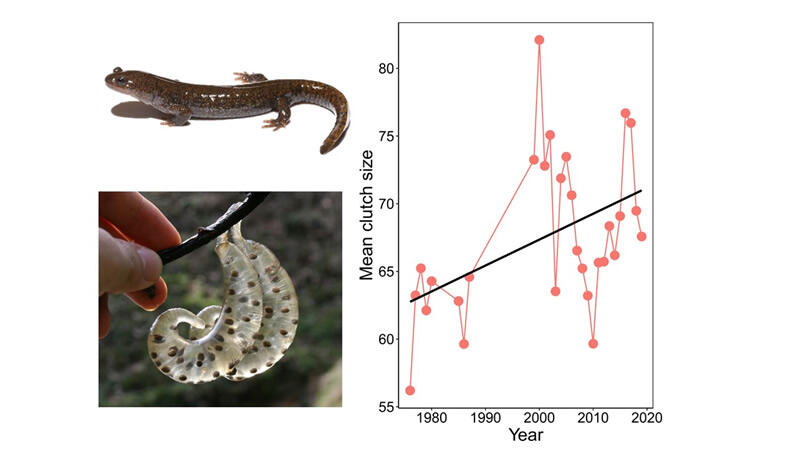A research group led by JSPS research fellow Hisanori Okamiya and (then) assistant professor Tamotsu Kusano, Graduate School of Science, Tokyo Metropolitan University has found an up to 20% increase in body size in the threatened Tokyo salamander over the past 40 years. The number of eggs produced by individual females during their reproductive period (clutch size) also increased by up to 30% over the four decades. It is likely the changes were promoted by earlier wakening from winter hibernation and a longer-lasting growth as a result of climate change. The findings were published in the Biological Journal of the Linnean Society.

(Credit: Tokyo Metropolitan University)
Evaluating the impact of climate change on living things is one of the major challenges of ecology, but while increased body size related to warming have been reported in a number of species, the magnitude of its effect and its direction (whether it works to make body size bigger or smaller) are not well understood. Moreover, there have been few such studies on small terrestrial animals such as the salamander.
The Tokyo salamander is a type of small salamander of 5-8 cm in length that is found in the hills and ranges of Fukushima Prefecture and the Kanto region (excluding Gunma Prefecture). It typically inhabits the forest floor. When they awake from their winter hibernation in early spring, they begin their breeding activities, spawning egg sacs filled with dozens of eggs that they leave in the water of small ponds and rice paddies.
The Graduate School of Science of Tokyo Metropolitan University has been observing the number of salamanders coming to breed at breeding sites in the Tokyo metropolitan area and the number of eggs in each sac produced by individual females continuously since 1976. Analysis of this data shows that the average clutch size of breeding cohort for the last 40 years has increased. The scope of the study was broadened, with mature body size and clutch size data collected from across the entire distribution range of the Tokyo salamander, because data from just one location may reflect phenomena unique to that site. Data were collected regarding 1,904 mature salamanders from 61 sites, and from 5,025 clutches in 96 sites. The data were divided into that from the 1970s and 1980s, and that from the 2000s and 2010s, with comparisons made along latitudes. The group found that across the entire distribution of the salamander, both body size and clutch size are larger now. The growth rate of both were higher at higher latitudes, with body size increasing by up to around 20% and clutch sizes up by as much as 30%.
Next, to gauge the impact of climate change, temperature data for the 1980s and the 2010s was obtained from the Japan Meteorological Agency and compiled into average temperatures for each decade and effective accumulated temperatures (the sum of viable temperature days for Tokyo salamander). It was found that both values had increased across the entire range of the salamander.
From these results, the research group concluded that "as a result of the increasing temperatures from climate change, the Tokyo salamander has increased its body size and its clutch size." The rate of observed increase was considerably higher than reported in studies of various other species around the world.
What is the mechanism behind the increasing body size? The research group believes that the bigger bodies and clutches now seen are the result of climate change bringing forward the season of the end of hibernation and the start of breeding by around one month. The shorter hibernation means a longer period of foraging, so that the animals are able to build up more resources for growth and reproduction than before.
The study was unable to uncover the reason for a higher growth rate in body and clutch size at higher latitudes. They hope to find the answers for the varying response to the warming climate in future by studying factors such as genetic differences and comparative heat resilience among the various Tokyo salamander habitats.
This article has been translated by JST with permission from The Science News Ltd.(https://sci-news.co.jp/). Unauthorized reproduction of the article and photographs is prohibited.




